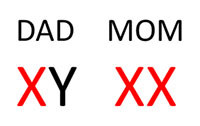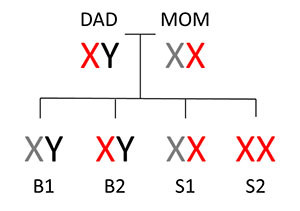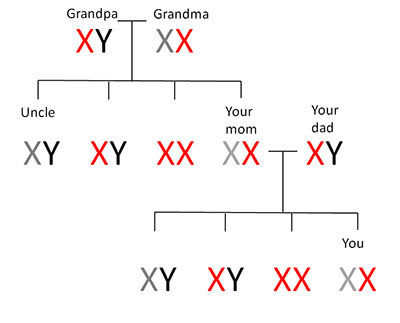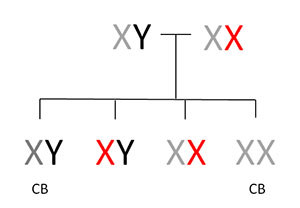
If I am a carrier for color blindness, would my son be color blind for certain?
September 12, 2013

- Related Topics:
- Color vision deficiency,
- X inactivation,
- X linked inheritance,
- Carrier
An undergraduate from Texas asks:
"My mom's brother is color blind but my mother and I are not. Because color blindness is sex linked and generally passed to males by the mother, if I have a boy will he be color blind for certain? (I am female.)"
No, not for certain. Even if your mom did end up getting the gene from your grandmother and you ended up getting it from your mom, your sons would still not automatically be color blind. They would each have a 50% chance.
As you can see, a lot has to happen for your sons to have even a chance at being color blind! Your mom had a 50% chance of inheriting the colorblind gene from her mom. If she got it, then you had a 50% chance of getting it too. And if you got it, then each of your kids has a 50% chance of getting it as well. Because of how color blindness works, only your sons that got the gene would end up color blind (assuming your partner isn’t color blind).
That last point in parentheses is an important one. Men always pass the color blind gene to their daughters but the daughters end up color blind only under the right circumstances.
For example, if your uncle married a woman who carried the color blind gene, then each of their sons and daughters would have a 50% chance of being color blind. In this case, it would look like the man, your uncle, passed his colorblindness down to his kids.
And if your uncle married one of those rare color blind women, then all of their kids would be color blind. Your aunt, uncle and all your cousins would all not be able to tell red from green.
Color blindness is not an easy trait to follow! It is more than mom passing it to her sons.
To understand all of this, we need to take a step back and look at how we inherit our genes. Then we’ll be able to understand why your sons actually have a pretty good shot at being able to tell red from green.
X-linked Traits
Most people have 23 pairs of chromosomes for a total of 46. We each get one set of 23 from our moms and one set of 23 from our dads.
Sprinkled throughout these chromosomes are the instructions for building and running each of us. These instructions mostly come in the form of genes.
Each of these genes has the instructions for one small part of you. One might tell your eyes how much pigment to make and so determine whether or not you’ll have brown eyes. And another might determine whether or not you have a certain receptor in your eye that lets you tell red from green.

This last gene is the one behind being color blind. It comes in two different versions—a working version and a nonworking one. If you have only nonworking versions, then you are color blind. What this means is that you only need one working copy to be able to tell red from green. This is where boys get into trouble…
As you may already know, most boys have an X and a Y chromosome and most girls have two X’s. This also means that most boys have one copy of the red-green receptor gene while most girls have two. And this matters because, as I said, you need just one working copy to be able to tell red from green.
Most humans have 23 pairs of chromosomes, or 46 total. (Image modified from Shutterstock)
So if a girl gets a nonworking copy of this receptor gene from just one parent, she’ll be able to tell red from green. The same is not true for her brother. One bad copy means color blindness for him.
What I want to do next is flesh this out with a few examples. First we’ll go through your example and see where all those 50%’s came from.
Then we’ll end it with a couple more examples that will help explain why, for example, a color blind dad can only pass his broken genes to his daughters. And why a color blind mom means that all her sons will be color blind too.
Your Example
I’ll start with what might happen in your case…two parents who aren’t color blind having a son that is. Let’s figure out what is going on in this situation.
If these two have a color blind son, then we know what each of these parents’ X chromosomes most likely looks like (at least with regard to the red-green receptor gene). We know that dad has a working copy of the red-green receptor and mom has one working and one nonworking copy. You’ll see below why we know this.
The way I will represent people in this answer is with a big XY for dads and sons and a big XX for mothers and daughters. They’ll look something like this:

I’ll use different colors to tell an X that can lead to color blindness from an X that can’t. If the X has a red-green receptor gene that works, then it will be red. If the X has a nonworking copy, then it will be gray. So a color blind dad would look like this:

Notice that his X is gray. Since this is the only X he has, he is color blind because he has no working copies of the red-green receptor gene. (We can ignore his Y.)
Here is what a mom who can see color but carries a color blind gene would look like:

Even though she has a gray X (one that has a nonworking red-green receptor gene), she can still tell red from green because of her red X. That X has a working copy of the gene and so keeps color blindness away. In genetic terms, she is called a carrier.
The genetic term that describes traits like color blindness is X-linked recessive inheritance. “X-linked” because it is on the X chromosome and “recessive” because a different version can dominate it. The working version hides the nonworking one.
Now we are ready to do an example. Let’s say that a carrier woman and a man that can tell red from green have kids. These are the four possible kids in terms of their X and Y chromosomes:

Let’s go through this in a little detail to figure out where each possibility came from.
As I said before, we inherit one of each pair of chromosomes from our mom and one from our dad. What I didn’t say was that which one you get is random. For example, you have a 50% chance of getting a Y from dad and a 50% chance of getting his X. (This is why couples have a 50% chance for a boy and a 50% chance for a girl.)
So brother 1 (B1), got mom’s gray X and dad’s Y and brother 2 (B2) got mom’s red X and dad’s Y. These are the only two possible sons that can come out of this.
The same sort of thing happened with the two sisters. Each got dad’s red X but sister 1 (S1) got mom’s gray X and sister 2 (S2) got mom’s red X.
Now we can see who is and isn’t color blind. First off, since brother 2 and sister 2 don’t have a gray chromosome, they are not color blind. They each only have working copies of the red-green receptor gene. The same is not true for brother 1 and sister 1.
Brother 1 and sister 1 both have a gray X but only brother 1 is color blind. This is because sister 2 has a red X that can provide the working gene needed to tell red from green.
This is where the 50% chance for boys comes from. If you are a carrier and your partner is not color blind, then this situation applies to you.
OK now let’s see what has to happen for you to be in this situation. This is a big one:

As you can see, the gray X had to pass from grandmother to mother to you for your sons to even have a chance at being color blind. If your mom actually had two red X’s like her hypothetical sister on her left, then you couldn’t get a gray. You would not have a color blind son.
Even if your mom did get your grandmother’s gray X, she would still need to pass it to you for you to be able to pass it to your kids. If instead she passed her red X to you, then again, none of your kids would be color blind.
This is a big reason why it is not for certain that your sons will be color blind. You may not even have inherited the color blindness gene.
And even if you did get that gray X, each of your sons would still only have a 50% chance at being color blind. Even in the “worst” case scenario, your sons will not automatically be color blind.
What I’ll do now is a couple more examples to show a situation where sons and daughters have a 50% chance of being color blind and another where all the kids are color blind. As you’ll see, these depend on dad being color blind.
A Couple More Examples
Let’s start off with a color blind dad and a carrier mom. Here are the four possibilities for their kids:

As you can see, dad has a gray X and so does mom. Of course, only dad is color blind because mom has a red X that can give her enough receptors to tell red from green.
A quick look shows that each son has a 50% chance of being color blind (marked “CB” in the image). The color blind son ended up that way because he got mom’s gray X…dad can’t pass his X to his sons. If he did, then the son would be a daughter.
Dad will always pass his gray X to his daughters. Otherwise they’d get a Y and be boys!
Since mom is a carrier, each daughter has a 50% chance to get a gray X and a 50% chance to get a red one from her. If she gets a gray from mom, she will end up with two gray X’s because of dad. She will be color blind.
So in this case, each of this couple’s children has a 50% chance for being color blind. It doesn’t look anything like mom passing her color blindness to her kids.
As the final example, let’s imagine our color blind girl grows up and has children with a color blind man. Here are the four possibilities for their kids:

A pretty boring family tree! All black and grays and no reds…
Since there are only gray X’s in this family, all the kids end up with just gray X’s. All the kids will be color blind.
Now if you feel up to it, here is one for you to solve:

What are the odds that each child has for being color blind? Is it different for sons and daughters?
Click here to get the answer!

Author: Dr. Barry Starr
Barry served as The Tech Geneticist from 2002-2018. He founded Ask-a-Geneticist, answered thousands of questions submitted by people from all around the world, and oversaw and edited all articles published during his tenure. AAG is part of the Stanford at The Tech program, which brings Stanford scientists to The Tech to answer questions for this site, as well as to run science activities with visitors at The Tech Interactive in downtown San Jose.
 Skip Navigation
Skip Navigation
